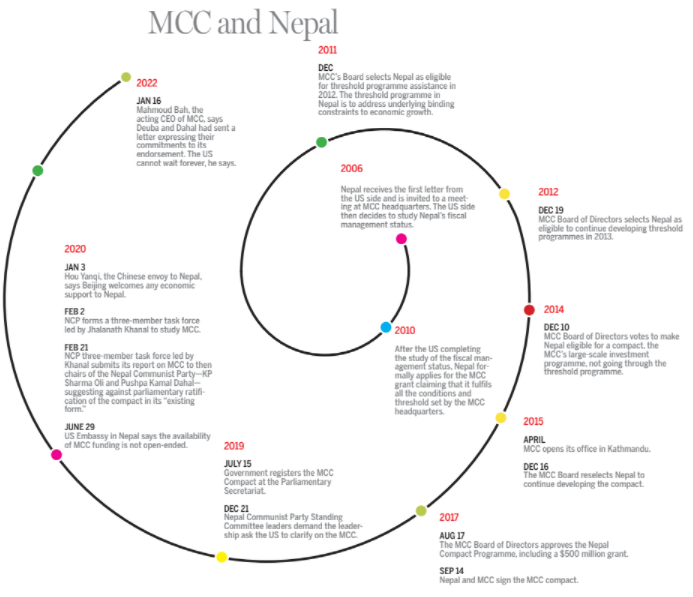
The Millenium Challenge Corporation-Nepal Compact once again has taken the centre stage in Nepal. The $500 million American grant which Nepal signed in September 2017 has emerged as a politically divisive issue.
Lately, the ruling coalition, which consists of the Nepal Congress, Communist Party of Nepal (Maoist Centre), CPN (Unified Socialist), Janata Samajbadi Party and the Rastriya Janamorcha, is facing a risk of a breakdown over the compact, as Prime Minister Sher Bahadur Deuba appears to be preparing to table it in Parliament. At least two of his coalition partners—Maoist Centre and CPN (Unified Socialist)—are opposed to the idea.
Meanwhile, Deuba is in talks with the main opposition CPN-UML in a bid to seek support. Ever since it was sent to the opposition in mid-July, the UML, which was ready for MCC’s endorsement, has been tight-lipped. It has not made its position clear.
During the agreement signing in 2017, Nepal committed an additional $130 million to support the MCC investment.
Just as the debate continues over passing the MCC, under which two infrastructure projects–electricity transmission and road improvement—are to be executed in Nepal, the government has spent a substantial amount of money to implement the selected projects under the programme.
According to the Millenium Challenge Account-Nepal (MCA-Nepal) Development Board, a government agency formed to implement projects under the MCC, though the expenditure has not been as per the allocation, a sizable amount has been spent until October last year.
“There has been disbursement of Rs4.34 billion till October 2021 for the implementation of the selected projects,” said Khadga Bahadur Bisht, executive director of the MCA-Nepal. The government has spent more than the MCC so far.
According to Bisht, the government has spent Rs2.65 billion while Rs1.69 billion has been spent by the MCC.
“Even though the spending from the government has been more so far, it will be adjusted later in line with the share of investment between the two sides,” Bisht told the Post.
One factor that contributed to low disbursement from the MCC compared to the Nepal government is that a sizable amount was spent from the government for land acquisition, according to Bisht.
The MCC had also stopped releasing resources for nine months from October 2019 when Nepal Parliament was initially supposed to endorse the Nepal Compact.


After the Finance Ministry made a request for releasing funds from MCC citing a possible impact of a slowdown in remittance inflows in foreign exchange reserves due to the coronavirus, MCC had started releasing funds under its share, according to officials.
“In order to implement the two projects, MCC is supposed to provide $500 million (Rs59.98 billion) while the government is supposed to spend $130 million (Rs15.59 billion).”
Construction of a 315km double circuit 400kv transmission line projects and improvement of part of the East-West Highway will be carried out under the $500 million US aid programme.
Five segments of transmission lines to be built are: New Butwal-India Border (18km), New Butwal-New Damauli (90km), New Damauli-Ramate (90km), Ratmate-New Hetauda (58km), and Ratmate-Lapsephedi (59km).
Once completed, the infrastructures are expected to provide a vital missing link for power projects of different river basins to the existing high voltage grid in Nepal.
Under the road project, a 77-km road from Bhalubang of Dang to the border point between Bardiya and Dang, which is part of the East-West Highway, will be upgraded.
According to the MCA-Nepal, most of the resources disbursed so far went for paying compensation for acquisition of land for building a substation at Ratmate of Nuwakot for the transmission line.
According to Bisht, the government’s Rs1.42 billion was spent for acquiring the land for the substation. Compensation rate was fixed in January 2020 and the MCA-Nepal has acquired 398 ropani (20.25 hectares) of land.
According to the Financial Comptroller General Office records, the government spent over Rs2.33 billion in the last fiscal year 2020-21 alone even though it was the year when controversy over the US aid programme reached its peak.
“There would have been more expenditures if numbers of activities were not halted due to uncertainty over MCC’s endorsement by Parliament,” said Bisht.
Despite continued controversy over the MCC-Nepal Compact, the government has continued to allocate a sizable budget to implement the projects.
In the last fiscal year, the government allocated Rs8.20 billion for implementing the MCC projects. In the current fiscal year 2021-22, the government has allocated Rs9.1 billion under the MCA-Nepal. Out of the total amount, Rs8 billion is expected to be received from the MCC, according to detailed expenditure estimates known as Budget Red Book.
“Despite differences among the political parties of the MCC compact, the executive of the state (government) has not given up on the MCC compact,” said Keshav Kumar Sharma, a board member at the MCA Nepal. “So, it was natural that the government tries to implement the projects.”
He said that a sizable budget has been allocated so that there would not be shortage of resources if the parliament endorses the MCC compact. “What message will it give if the government does not allocate funds for the MCC compact,” he asked.
Even though a significant amount was spent in land acquisition in the last fiscal year, the MCA-Nepal planned to spend on implementation of projects in the current fiscal year, according to officials.
“Our plan was to issue tenders, select contractors and make advance payments to the contractors to implement the transmission line projects in the current fiscal year,” said Bisht. “Over Rs6 billion is supposed to be paid to the contractors as a mobilization advance, mostly from the MCC.”
The controversy over the MCC-Nepal Compact started in 2020 after a section of leaders in the then Nepal Communist Party (NCP), including Pushpa Kamal Dahal, raised concerns about some of its provisions, which they said undermines Nepal’s sovereignty.
The NCP, which was formed in May 2018 after the formation of the CPN-UML and the Maoist Centre, however, was invalidated in March 2021 by the Supreme Court.
Dahal got his Maoist Centre back and supported Congress President Deuba to become prime minister.
While a majority of Maoist leaders are against the compact’s parliamentary approval, some leaders like Bhim Rawal from the UML have emerged as the biggest opposers of the American grant. The CPN (Unified Sociliast), formed after splitting from the UML, also is objecting to the compact’s endorsement from the House.
Some of the concerns of the opposers of the MCC include whether the agreement has primacy over Nepalis laws, whether it has any military connection, and whether the US would control the rights over the intellectual property generated through the implementation of the projects, among others. Even though the MCC headquarters in September last year sent a point-wise response to Nepal’s concerns which were sent by the Finance Ministry, a section of politicians is not convinced.
Amid controversy, the MCA-Nepal has halted a number of planned activities.
Land acquisition except for Ratmate substation has been put on hold since April 2020 after Covid-19 hit the country in early 2020.
“Uncertainty over the endorsement of the MCC-Nepal Compact continues hence no new land acquisition has begun yet,” said Bisht.
Bisht had earlier told the Post that the MCA-Nepal has already prepared all tender documents for the construction of substations and transmission lines.
“We are awaiting parliamentary ratification before calling tender bids,” he told the Post in September last year.
One reason for not issuing tender now, according to him, is that the MCA-Nepal sought to wait until the ratification because “reputed” contractors might not be interested to work amid uncertainty.
According to Bisht, the MCA-Nepal has also halted recruitment of consultants for transmission line projects after they were relieved of their duties earlier amid the coronavirus pandemic.
Bisht, however, said that the MCA-Nepal is now planning to go ahead with the plan of forest enumerations even though the fate of the compact hangs in the balance.
According to the MCA-Nepal, there are over 120 community forests with an estimated 215,000 trees, a majority of them are shrubs which need to be cleared.
“We have plans to start consultation with the local stakeholders for forest clearance starting this month,” said Bisht. “This is being done for keeping the project ready for implementation despite the uncertainty in the endorsement of the MCC Nepal-Compact from Parliament, because any other agency may implement the projects, if not MCA-Nepal.”













